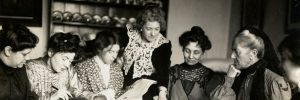Tucked away in the heart of Battersea, a unique piece of street art unfurls a vibrant narrative of the area’s rich history. “Battersea in Perspective,” a mural etched on a former pub on Dagnell Street, is more than just a striking work of art. It’s a visual journey through time, celebrating Battersea’s local charms, its industrial heritage, and radical political past.
Created by local artist Brian Barnes, the mural stands as a testament to the area’s vibrant cultural landscape. Taking center stage is the serenity of Battersea Park and the Peace Pagoda, flanked by the Thames River and the architectural elegance of the Albert and Chelsea Bridges.
Symbolism in the Sky: The Battersea Shield
Overarching the cityscape are golden circles, a depiction of the Battersea Shield. This iconic Celtic shield, dating back to 350BC, was discovered in the Thames mud during the construction of Battersea Bridge. Its discovery suggests it was offered to the gods, a custom prevalent during Celtic times. Today, this piece of history has found a home in the British Museum.
An Ode to Industrial Heritage
Filling the Battersea skies are images of a triplane and balloon, harking back to Battersea’s industrial past, much of which was nurtured under the local railway arches. These additions to the mural pay tribute to the area’s innovative spirit and industrial legacy.
Portraits of Influential Figures
The lower half of the mural features a series of portraits, each representing key figures in Battersea’s political history. Among them is John Archer, the UK’s first black council leader in 1913, whose political journey began in Battersea.
The mural also honours Shapurji Saklatvala, Battersea’s communist MP and the first MP of Indian heritage in the UK. He made headlines in 1926 when he was jailed for voicing support for striking coal miners during the general strike. His son, Kaikhoshro, went on to serve as a Spitfire pilot during the Second World War.
Another noteworthy figure on the mural is Charlotte Despard, a fearless suffragette who was jailed four times for her campaigning efforts. A friend of Karl Marx’s daughter, she also served as the secretary of the Friends of Soviet Russia and made headlines for her travels through the Soviet Union in the 1930s. After leaving Battersea, she moved to Dublin, where her house was targeted and destroyed by an anti-communist mob. Today, she is remembered through a plaque marking her former home and a local road named in her honour.
Hidden Gems within the Mural
Besides celebrating local personalities and landmarks like the Battersea Power Station, the mural hides intriguing details within its vibrant canvas. If you look closely, you’ll spot a miniature depiction of the very pub the mural is painted on, creating a delightful meta twist.
As colourful today as when it was first painted in 1988, the Battersea Mural serves as a local treasure. It’s a visual representation of the area’s dynamic history and its enduring charm. Next time you find yourself strolling through the streets behind Battersea Park, make sure to seek out this captivating piece of public art.
I talk about political campaigners who worked to abolish slavery in my Clapham Common Tour and the local slave owners who fought against them.




